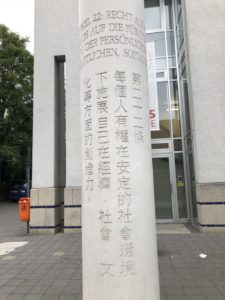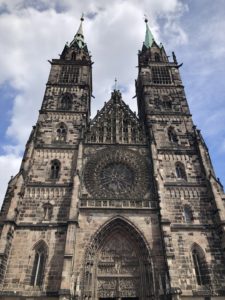(Unfortunately, since my computer has problems during the past few weeks, I was not able to publish my blogs over my stay in Munich. Now, I am happy to play the flashback of the past fantastic six weeks!)
Saying “Tschüss” (goodbye) to Munich, I started my journey again as a wanderer in Europe. I enjoyed my sixth weekend in Nürnberg, the city home to the painter Dürer, world-famous tin soldiers and also a witness of the important trials of Nazi after World War II. Though Nürnberg is known as the second largest city of Bayern, it took me less than an afternoon to visit every corner of the old town.
A step out of my hostel, I was attracted by the Way of Human Rights (Straße der Menschenrechte) which features 27 white, solemn pillars. Engraved in each white pillar is one article of the Universal Declaration of Human Rights in German and another language. This symbolizes that the recognition and protection of human rights should be borderless. The monument is intended as both a repudiation of past crimes of Nazi (Nürnberg was once “City of the Party Rallies” in the Nazi-era) and a permanent reminder that human rights are still regularly violated. While trying to understand the German articles on the pillars, I was reminded of the miseries and anti-humanistic crimes that happened in the Dachau Concentration Camp I had visited. I felt heavy but also filled with the responsibility to safeguard the words on the monument of Dachau, “Never again.”


Near the Hauptmarkt stands one of the most magnificent Gothic churches I’ve visited in Germany: St. Lorenz Church. The ceiling is star-shaped and in the middle of it hangs the giant wooden sculpture of Annunciation. From there leads to the Hauptmarkt where many shops sell fresh fruits, cheese and Düll (a specialty biscuit of Nuremberg). Though it is similar to markets in most German cities surrounded by joyful Bavarian music, beer, and fragrant food, I just love the atmosphere!





Abrecht Dürer is an inseparable part of the city of Nürnberg. This Renaissance painter, Da Vinci’s contemporary, is celebrated here as the name for streets, restaurants and the best artworks. I visited the old Dürer’s house and enjoyed his paintings and woodcuts which were dominated by religious stories and self-portraits. Famous ones include The Four Apostles, Adam and Eve, and Portrait of Maximilian I (his patron, a Bavarian King). I was fascinated particularly by his portrait of Adam and Eve in which the two figures look so tempted, yet the consequences of their fall still remain open to imagination. Undoubtedly, Dürer is a great painter and a pious Christian.
Then I visited the Toy Museum, climbed up to the Kaiserburg castle (beautiful but small), and had a wonderful meal at a beer garden. One thing I noticed in the Toy Museum is how the toys subtly mirror the “Zeitgeist” (A German word that means “spirit of the times”). For example, the picture below shows the tin soldiers whose production Nuremberg was famous for. Obviously, in the Nazi era, the fever for Hitler and the army spread to the children. Nowadays, those NS symbols are strictly forbidden in the public spheres. Sadly, war is always an important theme even for the toys for children.


